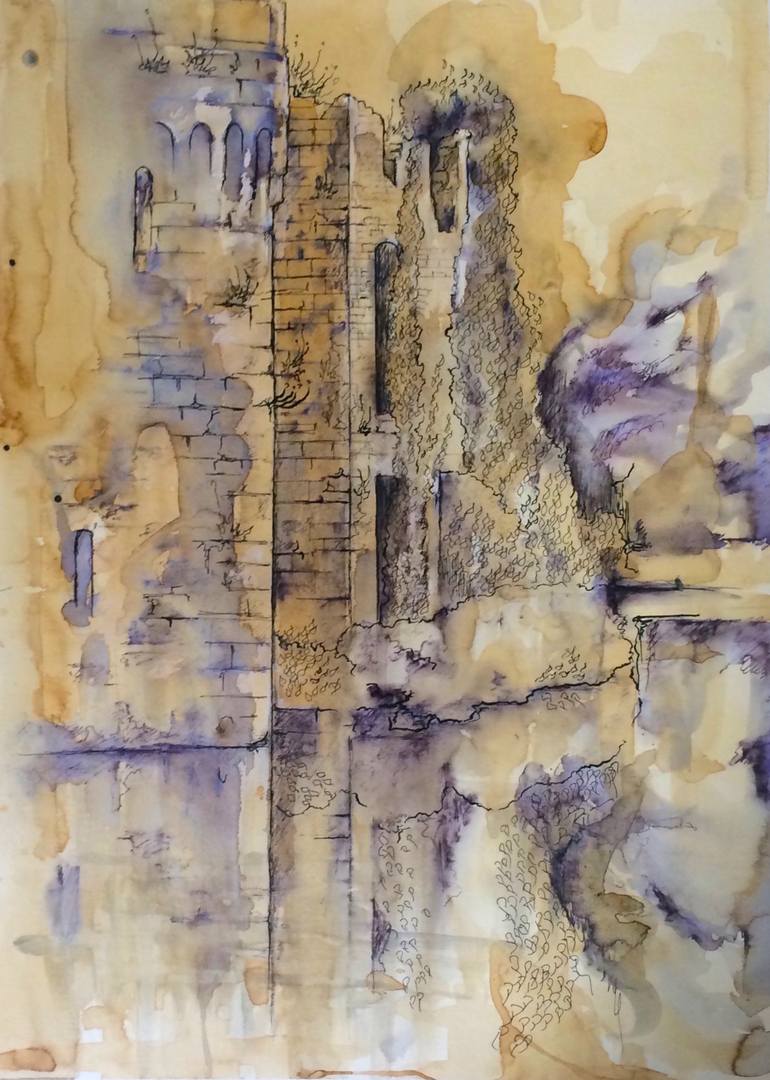


VIEW IN MY ROOM
Scotney Castle, Study 6 Painting
United Kingdom
Painting, coffee on Other
Size: 20.1 W x 29.1 H x 1.2 D in
Ships in a Box
About The Artwork
This is the sixth of a series of studies I did of Scotney Castle after being asked to participate in SkyArt's “Landscape Artist of the Year”. Eight contestants per episode were asked to depict an undisclosed view of the castle within four hours. This particular study is of the Southern side of the original castle--a moated manor house built in the 14th century on an estate inhabited since the 12th century. It depicts the only remaining tower from the original building, and part of the 17th century addition of the Eastern wall. As I familiarised myself with the castle and grounds, I became fascinated by the history and legends surrounding the estate, and the myriad alterations made on the castle over it's nearly 700 year old history. The castle is a marvellous jumble of architectural styles. The original castle, of which the tower remains, was renovated in the 16th century with Elizabethan architecture. A Palladian addition was made to the East side of the castle in the 17th century, and then was destroyed in the 19th century to create a fashionable “folly”. The idea of semi-destroying a 14th century castle in the 16th century, and then a 17th century addition in the 19th century for decoration makes me wince. It's something we would never condone today in our struggle to preserve historical legacy. However, these marks of time undeniably add to the fascination of the castle, and the people and points in history it represents. In London, the city I focus most of my cityscapes on, one is sometimes given a brief view of the bones of a historical building through the chaos of urban development. In run down areas, or half-finished construction sites, one is sometimes given a privileged views of spaces not seen by anyone other than the original builder for hundreds of years—spaces between bricks, for instance, never even viewed by it's original inhabitants. These glimpses are bittersweet, to say the least, because in almost all cases, deliberate destruction is never done in half parts, and a glimpse is just that—a tiny percentage point of time in the history of a building before it vanishes for good. Through it's deliberate disrepair, however, Scotney Castle defies the inevitable destruction of history by modernisation. In being intentional, the 19th century architect responsible for destroying the Palladian addition to the castle paid particular attention to intricate and unusual parts of the castle's construct. The walls and structures that remain allow our imaginations to quite successfully visualise the entirety of the castle as it was, while still being able to explore how it was built over time. In doing so, it incorporates the castle with the ancient estate on which it was built, which was first claimed even earlier, in the 12th century. This process of construction and destruction gives us a glimpse not only into the history of the castle, but a burgeoning interest in history itself from the 17th to 19th century. The Palladian style represented a return to Roman architectural styles in the run-up to the Enlightenment, which looked to Grecian and Roman democracies that placed reason over blind faith. Ironically, a burgeoning 19th century interest in archeology and historical legacy created a fashionable interest in decorative ruins, and was responsible for the purposeful “ruining” of the eastern addition. Scotney Castle preserves a fascinating historical legacy, which allows us to travel through the worlds of it's different inhabitants. Note: This work has been painted on conservation grade paper mountboard in order to do multiple layers of detail work and washes. I utilize coffee because of it's unique physical mark making abilities. As liquid coffee evaporates from the center out to create a stain, the tension makes particles flow to the outer edges of the original mark which is stuck in place. Because ground coffee has larger particles than ink, which is refined, this creates an exaggerated outline. This allows me to create a record of each layer of wash I do in coffee, and also impacts certain types of ink I use as well. This process allows me to engage in a sort of building process that historical architecture itself goes through.
Details & Dimensions
Painting:coffee on Other
Original:One-of-a-kind Artwork
Size:20.1 W x 29.1 H x 1.2 D in
Frame:Not Framed
Ready to Hang:Not applicable
Packaging:Ships in a Box
Shipping & Returns
Delivery Time:Typically 5-7 business days for domestic shipments, 10-14 business days for international shipments.
Handling:Ships in a box. Artists are responsible for packaging and adhering to Saatchi Art’s packaging guidelines.
Ships From:United Kingdom.
Customs:Shipments from United Kingdom may experience delays due to country's regulations for exporting valuable artworks.
Have additional questions?
Please visit our help section or contact us.
United Kingdom
Thousands Of Five-Star Reviews
We deliver world-class customer service to all of our art buyers.
Global Selection
Explore an unparalleled artwork selection by artists from around the world.
Satisfaction Guaranteed
Our 14-day satisfaction guarantee allows you to buy with confidence.
Support An Artist With Every Purchase
We pay our artists more on every sale than other galleries.
Need More Help?